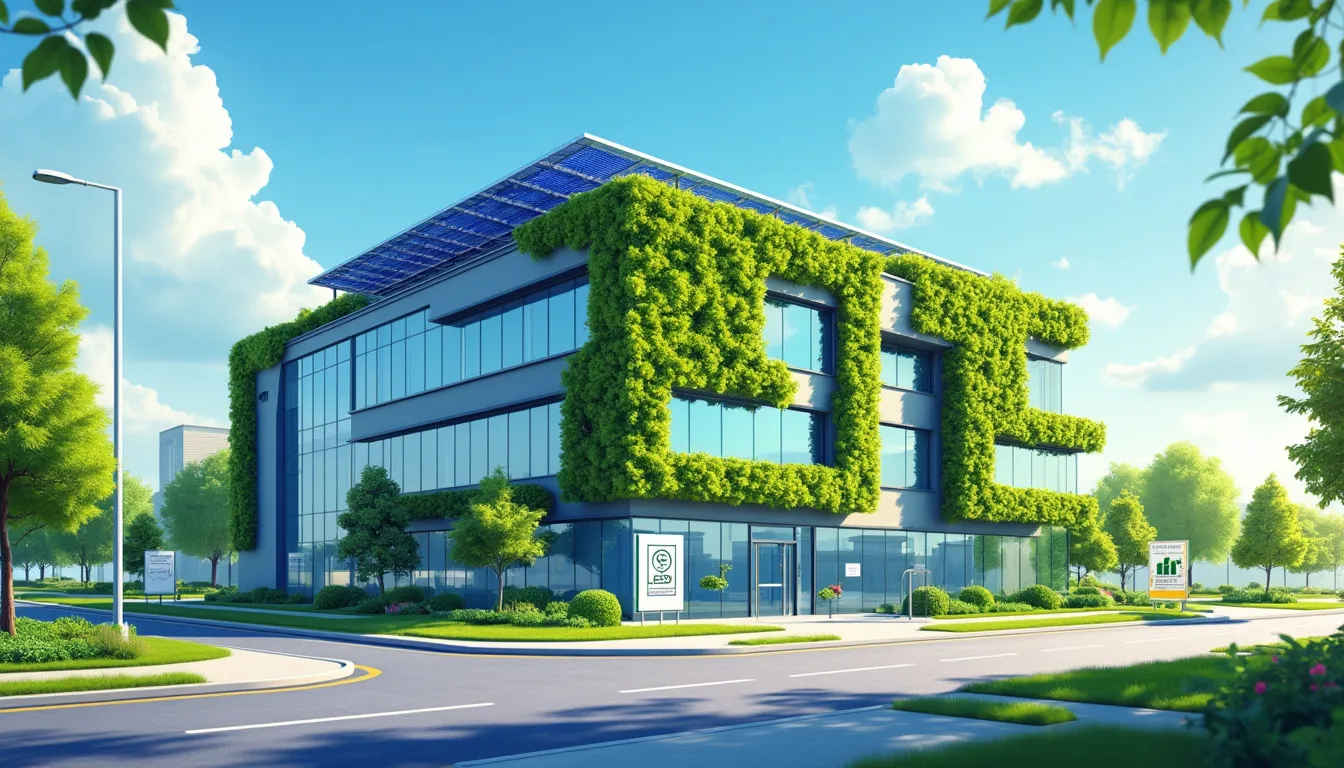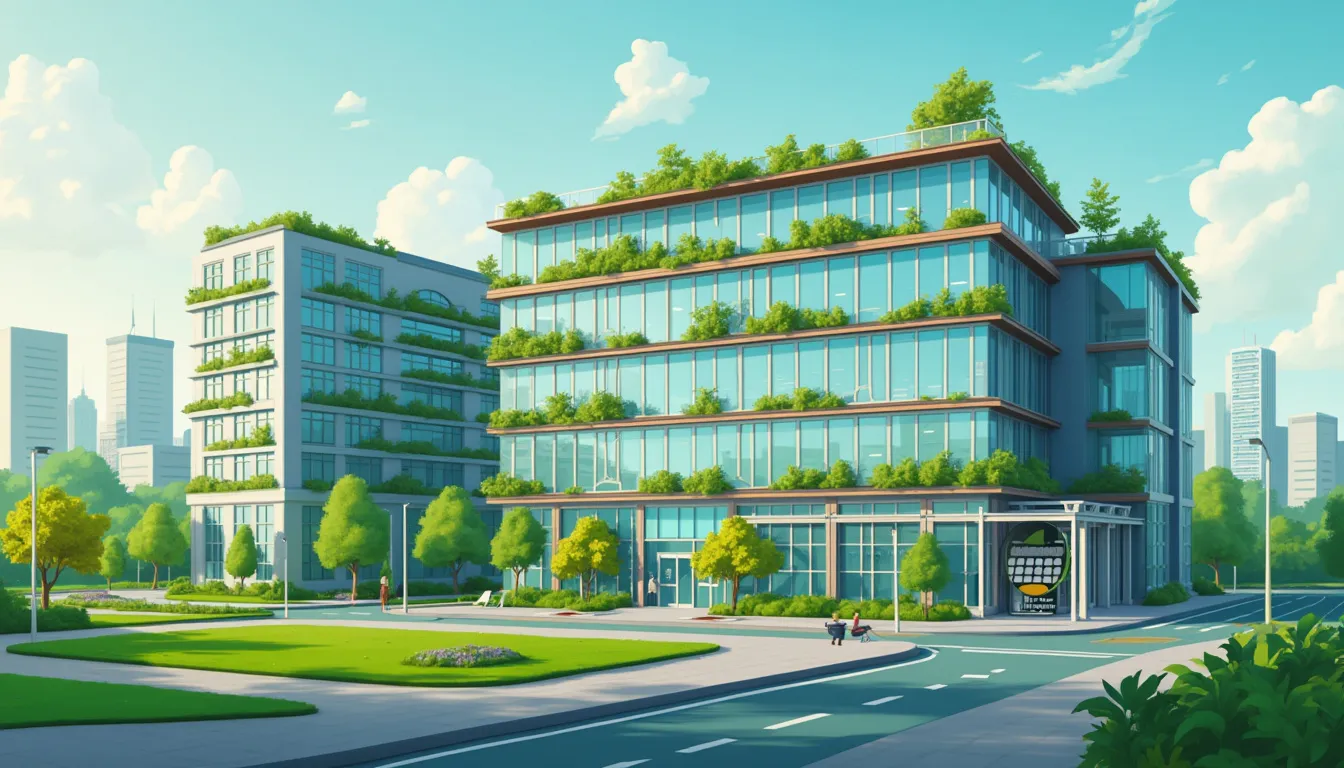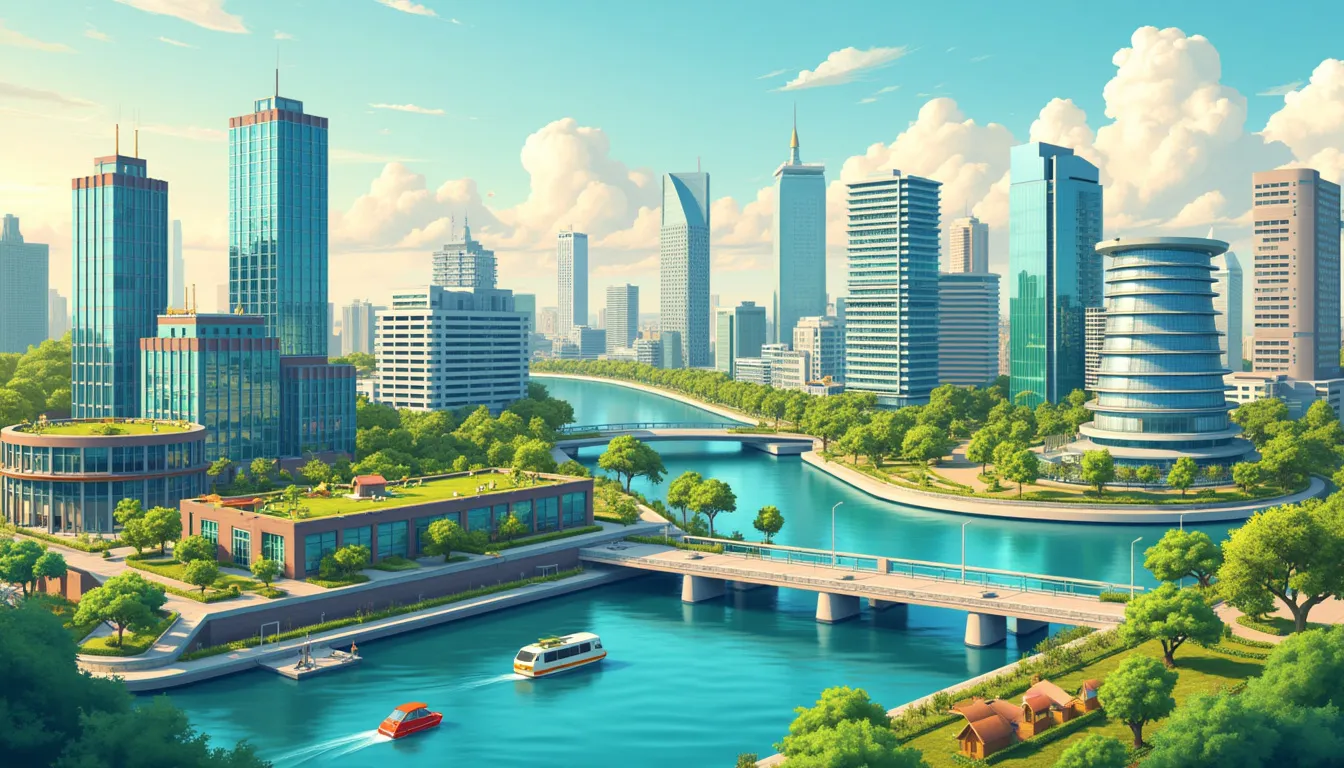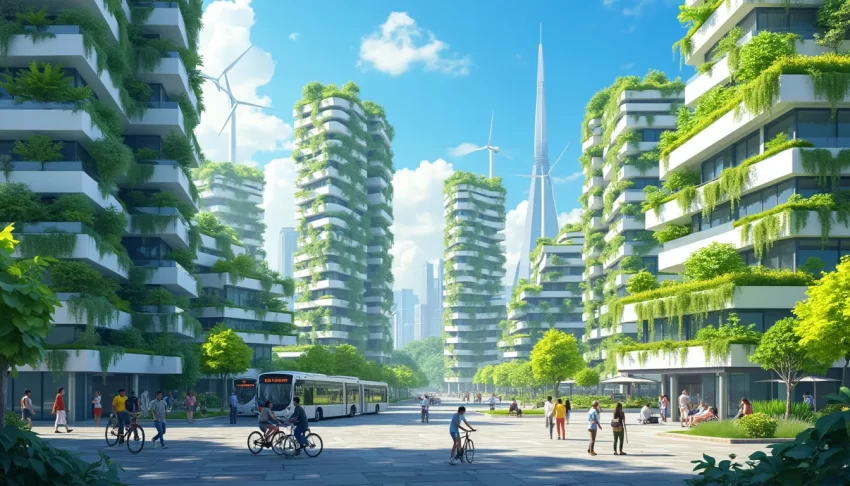In our rapidly changing world, where environmental impacts are becoming impossible to ignore, achieving sustainability is no longer just an option—it’s a necessity. Enter LEED certification, a globally recognized symbol of excellence in green building. LEED, which stands for Leadership in Energy and Environmental Design, sets the standard for sustainable, efficient, and eco-friendly construction. But what exactly makes a LEED certified building so vital in today’s context?
First and foremost, LEED certification is more than just a green stamp of approval. It’s a testament to a building’s performance in key sustainability metrics, such as energy efficiency, water conservation, and the use of sustainable materials. More importantly, LEED certified buildings contribute to healthier indoor environments, which can significantly improve the well-being and productivity of their occupants.
The benefits of LEED certification extend far beyond environmental responsibility. Buildings that achieve this standard often see considerable reductions in operating costs due to improved resource management. Moreover, LEED certified buildings are increasingly becoming the future of construction, driven by market demand, governmental incentives, and a growing awareness of our collective responsibility to protect the planet.
As you delve deeper into this article, you’ll discover the key features of LEED certified buildings and the steps to achieve this coveted certification. We’ll also share compelling case studies and success stories that highlight the transformative impact of LEED certification on building performance and occupant well-being. By understanding and embracing these practices, both individuals and business owners can make informed, impactful choices that pave the way for a sustainable future.
Introduction to LEED Certification
Overview of LEED and Its Importance for Sustainable Development
The Leadership in Energy and Environmental Design (LEED) certification is a globally recognized symbol of excellence in green building. Established by the U.S. Green Building Council (USGBC), the LEED program provides a comprehensive framework for builders, architects, and property managers to create healthy, highly efficient, and cost-saving green buildings. With an increasing emphasis on sustainability, LEED certification has gained momentum as both individuals and businesses strive to reduce their environmental impact.
LEED certification offers a roadmap for designing, constructing, and operating buildings that minimize resource consumption, lower carbon footprints, and enhance occupant wellbeing. By focusing on key areas such as energy efficiency, water conservation, and sustainable material usage, the program ensures that certified buildings contribute positively to the environment and society.
Benefits of LEED Certification for Buildings
Understanding the myriad benefits of LEED certification is crucial for any property owner or developer aiming to create sustainable spaces. Here are some of the key advantages:
- Energy Savings: LEED certified buildings are designed to optimize energy use, often employing advanced technologies such as solar panels, efficient HVAC systems, and smart grids. These measures can significantly lower energy bills and reduce greenhouse gas emissions.
- Water Conservation: Utilizing innovative water-saving technologies, such as low-flow fixtures, water-efficient landscaping, and rainwater harvesting systems, LEED certified buildings help preserve our precious water resources.
- Enhanced Indoor Air Quality: LEED prioritizes the health and comfort of building occupants by ensuring good ventilation, using low-emission materials, and maintaining high standards of cleanliness. This results in healthier indoor environments, reducing allergens and pollutants.
- Marketability and Value: LEED certification can enhance a building’s marketability. Properties with such certifications often achieve higher rental rates, attract quality tenants, and enjoy greater market appeal. Studies have shown that green properties tend to have higher occupancy rates and can command a sales premium.
- Regulatory Incentives: Many governments and local authorities offer incentives, such as tax credits and zoning allowances, for LEED certified buildings. These incentives can help offset the initial costs of green construction and encourage the adoption of sustainable practices.
- Environmental Impact: Perhaps the most significant benefit is the reduction in environmental impact. LEED certified buildings contribute to lowering carbon footprints, minimizing waste, protecting natural habitats, and fostering a sustainable future.
Why LEED Certified Buildings Are the Future of Construction
The construction industry is at a pivotal point, grappling with the pressing need to address climate change and resource scarcity. In this context, LEED certified buildings represent the future of construction for several compelling reasons:
- Responding to Climate Change: The construction sector accounts for a substantial share of global carbon emissions. LEED certification sets stringent criteria for energy efficiency and renewable energy integration, directly addressing the need to combat climate change. As regulatory pressures increase, LEED certified buildings will be better positioned to comply with evolving standards and mitigate environmental impact.
- Economic Sustainability: While the initial investment in LEED certified buildings may be higher, the long-term economic benefits are considerable. Reduced operational costs, due to lower energy and water consumption, combined with potential tax incentives, make these buildings financially viable. Furthermore, increased asset value and market differentiation underscore their economic appeal.
- Cultural Shift Towards Sustainability: There is a growing cultural and consumer shift towards sustainability. People are more conscious of their environmental impact and prefer to engage with businesses and spaces that share their values. LEED certified buildings align with these preferences, positioning them as forward-thinking and socially responsible choices.
- Technological Advancements: Rapid advancements in technology are making sustainable construction more accessible and efficient. Innovative building materials, smart sensors, and AI-driven energy management systems are transforming the landscape of green building. LEED certification continually evolves to incorporate these advancements, ensuring that certified buildings remain at the cutting edge of sustainability.
- Regulatory Landscape: Government regulations worldwide are increasingly mandating or incentivizing sustainable construction practices. LEED certification offers a recognized and respected framework that aligns with these regulations, ensuring compliance and reducing the risk of future penalties or legal issues.
In essence, LEED certified buildings encapsulate the principles of modern, environmentally responsible construction. By prioritizing human health, reducing waste, and optimizing resource use, these buildings set a benchmark for what sustainable development can achieve. As we move forward, embracing LEED certification will be critical for creating resilient, inclusive, and sustainable communities.

Key Features of LEED Certified Buildings
Energy Efficiency Measures in LEED Certified Buildings
Energy efficiency stands at the heart of LEED (Leadership in Energy and Environmental Design) certified buildings. These structures incorporate a variety of innovative technologies and practices designed to reduce energy consumption and minimize carbon footprints. One key strategy is the integration of advanced HVAC (heating, ventilation, and air conditioning) systems. These systems are designed not only to maintain optimal indoor temperatures but also to operate at peak efficiency. For example, variable refrigerant flow (VRF) systems allow for precise control over individual zones within a building, reducing energy wastage.
Additionally, LEED certified buildings often leverage smart building management systems. These systems utilize sensors and automated controls to monitor and optimize energy usage in real-time. For instance, lighting systems can be programmed to adjust based on the presence of natural daylight or occupancy levels, significantly cutting down on unnecessary electric lighting.
Renewable energy sources also play a crucial role. Many LEED certified buildings employ solar panels, wind turbines, or geothermal systems to generate clean energy. These not only support sustainability but also help in reducing operational costs over time.
Water Conservation Strategies
Water conservation is another pivotal aspect of LEED certified buildings. Sustainable water management practices are crucial in reducing the overall environmental impact and ensuring resource availability for future generations. One common feature is the installation of low-flow plumbing fixtures. These fixtures, such as faucets, showerheads, and toilets, are designed to minimize water usage without compromising performance.
Rainwater harvesting systems are also frequently incorporated in LEED certified designs. These systems collect and store rainwater, which can then be used for non-potable applications like irrigation and flushing toilets. This reduces dependency on municipal water supplies and helps alleviate the pressure on local water resources.
Greywater recycling is another innovative strategy. Greywater, which refers to lightly used water from sinks, showers, and laundry, is treated and repurposed for uses such as landscape irrigation. This not only conserves water but also reduces wastewater generation and treatment costs.
Use of Sustainable Building Materials
The use of sustainable building materials is a hallmark of LEED certified buildings. These materials are chosen for their low environmental impact, durability, and ability to enhance indoor air quality. Recycled materials, for example, are commonly used in various construction elements. Recycled steel, glass, and aggregate can significantly reduce the need for virgin materials and cut down on the energy-intensive extraction processes.
Locally sourced materials offer another sustainable option. By procuring materials from nearby sources, LEED certified projects can reduce transportation emissions and support local economies. This approach is not only environmentally beneficial but also promotes regional industries and job creation.
Furthermore, many LEED certified buildings incorporate materials with low or no volatile organic compounds (VOCs). VOCs are harmful chemicals that can off-gas from certain building materials, adversely affecting indoor air quality. By choosing low-VOC paints, adhesives, and finishes, LEED certified buildings help create healthier indoor environments for occupants.
Indoor Environmental Quality
Indoor environmental quality (IEQ) is a critical component of LEED certified buildings, focusing on creating healthy, comfortable indoor spaces for occupants. One significant factor in achieving superior IEQ is ensuring adequate ventilation. Enhanced ventilation systems are designed to provide a continuous supply of fresh outdoor air, while efficiently removing indoor pollutants and contaminants.
Moreover, LEED certified buildings often feature advanced air filtration systems. High-efficiency particulate air (HEPA) filters and similar technologies can capture fine particulates and allergens, significantly improving indoor air quality. These systems are particularly beneficial in urban areas where outdoor air quality might be compromised.
Natural lighting is another key aspect of IEQ. By designing spaces with ample windows and strategically placed skylights, LEED certified buildings maximize natural light penetration. This not only reduces the need for artificial lighting but also enhances occupant health and productivity. Studies have shown that access to natural light can improve mood, cognitive function, and even sleep patterns.
Additionally, LEED certified buildings often utilize acoustic design principles to manage noise levels. Soundproofing and acoustic treatments can help create a quieter, more pleasant indoor environment, reducing stress and increasing overall comfort for occupants.
In summary, the key features of LEED certified buildings—from energy efficiency and water conservation to sustainable materials and superior indoor environmental quality—demonstrate a comprehensive approach to sustainability. By integrating these core elements, LEED certified buildings not only benefit the environment but also create healthier, more efficient, and more enjoyable spaces for everyone.

Steps to Achieving LEED Certification
Understanding LEED Rating Systems and Categories
To embark on the journey towards LEED certification, it’s vital to first grasp the LEED rating systems and categories. The LEED (Leadership in Energy and Environmental Design) certification program, overseen by the U.S. Green Building Council (USGBC), provides a framework for healthy, highly efficient, and cost-saving green buildings. LEED-certified buildings come in various forms, tailored to different types of projects, including New Construction, Existing Buildings, Commercial Interiors, and more.
Each LEED project is graded on multiple criteria, which include Sustainable Sites, Water Efficiency, Energy and Atmosphere, Materials and Resources, Indoor Environmental Quality, Innovation, and Regional Priority. Points are awarded based on how the building meets these criteria, leading to different levels of certification – Certified, Silver, Gold, or Platinum.
Planning and Designing for LEED Certification
Once the rating system is selected, the next crucial step is the planning and design phase. Successful LEED certification begins with mindful planning and a commitment to sustainable practices from all stakeholders involved. It is here that you should involve a LEED-accredited professional. Their expertise can help navigate the specific LEED requirements and ensure that the project aligns with the standards for certification.
Creating a detailed, sustainable design strategy is essential. This involves choosing a site that minimizes environmental impact, such as those with existing infrastructure or brownfield sites. Additionally, the design should incorporate energy-efficient systems and renewable energy sources whenever feasible, aiming to reduce the building’s carbon footprint right from the start.
Consideration for public transportation accessibility, pedestrian pathways, and bicycle storage can also earn crucial points under the Sustainable Sites category. Importantly, fostering a collaborative environment where architects, engineers, and other professionals work together can significantly impact the project, ensuring all LEED aspects are covered.
Key Considerations During Construction
Transitioning from design to construction requires maintaining the sustainable standards set during planning. Keep the sustainability spirit alive by prioritizing resource management and waste reduction. Throughout the construction phase, it’s crucial to use materials that are locally sourced, recycled, and have a high life cycle assessment score.
Construction waste management is another significant area that affects LEED certification. Developing a comprehensive plan to reduce, recycle, and properly dispose of waste can contribute valuable points. Additionally, ensuring that the site remains pollutant-free by controlling runoff and reducing dust and emissions will help protect the surrounding environment.
During construction, indoor environmental quality should remain a priority. This includes managing air quality through proper ventilation systems and using low-emitting materials to reduce indoor pollutants. Protecting and enhancing natural resources, such as incorporating native landscaping that minimizes water use, will further align the project with LEED standards.
Documentation and LEED Certification Process
The final step in achieving LEED certification lies in meticulous documentation and adherence to the LEED certification process. Documentation serves as proof that the project met the required LEED standards and is essential for the USGBC’s review.
Start by creating a comprehensive plan that includes detailed records of materials used, energy systems implemented, and sustainability strategies adopted. This documentation should be collected and maintained throughout the construction phase. Importantly, accurate and consistent record-keeping is key to avoid any discrepancies during the certification review.
Once construction is complete, submit the project for LEED review. The USGBC will verify all documentation and perform site inspections, if necessary. It is during this review phase that the project’s sustainability measures are evaluated against the LEED criteria. Receiving feedback from the initial review may require some minor adjustments or additional documentation.
After addressing any feedback, a final submission to the USGBC will determine the building’s certification status.
In summary, achieving LEED certification is a comprehensive process that begins with understanding the LEED rating systems, followed by careful planning and design, conscientious construction, and thorough documentation. By committing to these steps, building owners and developers can create environmentally responsible spaces that not only benefit the planet but also offer economic and health advantages to occupants.

Case Studies and Success Stories
Examples of Notable LEED Certified Buildings Worldwide
When we talk about LEED certified buildings, several iconic structures come to mind that have set benchmarks in sustainability. From towering skyscrapers to public libraries, these edifices showcase exemplary commitment to environmental stewardship.
Consider the Bank of America Tower in New York City, a marvel of sustainable architecture. As one of the greenest skyscrapers, it boasts Platinum LEED certification, the highest level achievable. With features like a rainwater harvesting system and floor-to-ceiling insulating glass to maximize natural light and reduce energy costs, this building exemplifies how LEED standards can be integrated into large-scale commercial projects.
Another fantastic example is the California Academy of Sciences in San Francisco. This LEED Platinum building incorporates a living roof with over 1.7 million native plants, which aids in insulation and reduces urban heat island effects. The Academy also uses an on-site solar panel system, providing 213,000 kWh of energy annually. These measures not only contribute to sustainability but enhance the building’s aesthetic and functional appeal.
In Asia, the International Commerce Centre in Hong Kong stands out. This 118-story skyscraper has achieved LEED Gold certification. The building integrates advanced energy-efficient systems, such as smart sensors and high-performance glazing, illustrating that even the tallest buildings can prioritize sustainability.
Lessons Learned from Successful LEED Certifications
These notable case studies illustrate several key lessons that can be applied to both new constructions and retrofits aiming for LEED certification:
1. Holistic Planning and Integration: Projects like the Bank of America Tower and the California Academy of Sciences underscore the importance of incorporating sustainability goals from the project’s inception. It’s crucial to engage architects, engineers, and sustainability consultants early in the planning phase to ensure all elements work harmoniously towards LEED certification.
2. Innovative Use of Technology: Technologies like smart sensors in the International Commerce Centre demonstrate how modern advancements can optimize building performance. Investing in emerging technologies can lead to significant energy savings and better occupant comfort, contributing to higher LEED scores.
3. Community and Occupational Wellbeing: Take, for example, the Phipps Conservatory Center for Sustainable Landscapes in Pittsburgh. This LEED Platinum facility not only emphasizes energy and water efficiency but also fosters a healthy indoor environment using non-toxic materials and natural lighting. Such measures can drastically improve occupant wellbeing and productivity, vital for both residential and commercial structures.
4. Retrofitting for Sustainability: Many LEED projects involve older buildings retrofitted to meet modern standards. The Empire State Building’s recent renovations, which include energy-efficient windows and a state-of-the-art chiller plant, resulted in a 38% reduction in energy consumption, illustrating that older buildings can also achieve high sustainability standards.
Impact of LEED Certification on Building Performance and Occupant Wellbeing
The benefits of LEED certification extend far beyond environmental impact, reaching into the realms of economic performance and human health. Here’s how:
Enhanced Building Performance: LEED certified buildings like the ones mentioned often see significant reductions in energy and water use. According to the U.S. Green Building Council (USGBC), LEED buildings typically use 25% less energy and 11% less water than non-certified buildings. This not only reduces operating costs but also contributes to a lower overall carbon footprint.
Economic Benefits: LEED certification can also lead to higher property values. Studies have shown that LEED certified buildings can command rental premiums and have higher occupancy rates. For instance, the Vancouver Convention Centre, with its LEED Platinum certification and extensive sustainability features, remains a prime location for events, demonstrating how green buildings can attract business.
Occupant Wellbeing: A growing body of research indicates that the design elements required for LEED certification can positively impact human health. Increased natural light, better air quality, and the use of non-toxic materials create healthier indoor environments. This, in turn, can enhance productivity, reduce sick days, and improve overall occupant satisfaction. For example, the Genzyme Center in Cambridge, Massachusetts, designed with ample natural light and excellent indoor air quality, showcases how a well-designed green building can enhance occupant wellbeing and productivity.
Social and Community Impact: LEED certified buildings can also play a crucial role in fostering sustainable communities. By reducing the environmental impact, these buildings can contribute to overall community health and resilience. Buildings like the Bullitt Center in Seattle, often referred to as the greenest commercial building in the world, serve as educational tools and community hubs, inspiring others to pursue sustainability.
These case studies and success stories provide a wealth of knowledge and inspiration for anyone looking to embark on the journey towards LEED certification. By learning from these examples, we can better navigate the complexities of sustainable building practices and create structures that are not only eco-friendly but also beneficial to all stakeholders involved.
As we’ve journeyed through the world of LEED certification, it’s crystal clear that sustainable building practices are not just a trend but a necessity. LEED certified buildings stand as a beacon of what the future of construction should embody, rooted in efficiency, responsibility, and foresight. From the adoption of energy-efficient designs and cutting-edge water conservation measures to the use of sustainable building materials and enhancement of indoor environmental quality, LEED certification provides a robust framework that balances environmental stewardship with practical benefits.
The pursuit of LEED certification may initially seem daunting, but understanding its rating systems and categories serves as the first critical step. Planning and designing with sustainability at the forefront, paying meticulous attention to construction practices, and rigorously documenting each step, culminate in achieving the green certification that can significantly elevate a building project.
Real-world examples, like the LEED-certified Empire State Building retrofit, or the progressive initiatives of the Bank of America Tower, highlight the transformative impact of these practices. They not only lead to significant reductions in operational costs and environmental footprints but also enhance occupant wellbeing and productivity. These case studies serve to inspire and illustrate the tangible benefits and the ripple effects that sustainable buildings can create in communities.
As individuals and business owners, embracing LEED certification extends beyond the construction process. It’s about cultivating a mindset that values efficiency, sustainability, and the long-term health of our planet. Small steps, such as selecting energy-efficient appliances, prioritizing natural lighting, or integrating nature within indoor spaces, can contribute to your broader sustainability goals.
In sustainable development, every action counts, and together, we can drive the momentum toward a greener, more sustainable future. Whether you’re planning your next home project or looking to enhance your business infrastructure, consider the principles of LEED certification as a guide. Remember, our buildings are more than just structures; they are an integral part of the life cycle of our environment. By striving for LEED certification, we are not only investing in better buildings but also in a healthier, more resilient planet for generations to come.
Support Us: Check out our recommended products on Amazon.

